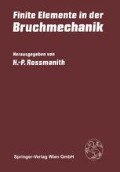Zusammenfassung
Im letzten Jahrzehnt ist die numerische Analyse bruchmechanischer Aufgabenstellungen zu einem Forschungszweig geworden, der durch ein hohes Maß an wissenschaftlicher Aktivität gekennzeichnet ist. Übersichtsartikel über die Anwendung numerischer Verfahren — insbesondere der Methode der Finiten Elemente — in der Bruchmechanik erscheinen mit gewisser Regelmäßigkeit in der Literatur /1/, /2/, /3/, /4/. In diesem Beitrag wird auf die Berechnung des singulären Spannungsfeldes um die Rißspitze und der damit assoziierten bruchmechanischen Kenngrößen und Parameter eingegangen. Inelastisches (z.B. elasto-plastisches) Bruchverhalten, welches in geeigneter Weise mit konventionellen, nichtsingulären Elementen beschrieben wird, wird an anderer Stelle eingehend behandelt. Die hier dargelegten Entwicklungen beziehen sich im wesentlichen auf die in der linear-elastischen Bruchmechanik charakteristischen Singularitäten für ebene und räumliche Probleme.
Access this chapter
Tax calculation will be finalised at checkout
Purchases are for personal use only
Preview
Unable to display preview. Download preview PDF.
Literatur
Kuna, M.: Some Applications of the Finite Element Method to Fracture Mechanics of Elastic and Elastic-Plastic Bodies. In: Proceedings of the First International Conference on Numerical Methods in Fracture Mechanics (Luxmoore, A. R., Owen, D. R. J., Hrsg.), S. 537–549. Swansea: Pineridge Press. (1978).
Gallagher, R. H.: A Review of Finite Element Techniques in Fracture Mechanics. In: Proceedings of the First International Conference on Numerical Methods in Fracture Mechanics (Luxmoore, A. R., Owen, D. R. J., Hrsg.), S. 1–25. Swansea: Pineridge Press. (1978).
Pian, T. H. H.: Crack Elements. In: Proceedings of World Congress on Finite Element Methods in Structural Mechanics. S. F.1-F.39. Bournemouth. 1975.
Zienkiewicz, O. C.: The Finite Element Method, 3. Aufl. London: McGraw-Hill. (1977).
Broek, D.: Elementary Engineering Fracture Mechanics, 2. Aufl. Alphen aan den Rijn: Sijthoff/Noordhoff. 1978.
Tong, P., Pian, T. H. H., Lasry, S.: A Hybrid Element Approach to Crack Problems in Plane Elasticity. International Journal for Numerical Methods in Engineering 7, S. 297–308 (1973).
Pian, T. H. H., Moriya, K.: Three-Dimensional Fracture Analysis by Assumed Stress Finite Elements. In: Proceedings of the First International Conference on Numerical Methods in Fracture Mechanics (Luxmoore, A. R., Owen, D. R. J., Hrsg.), S. 363–373. Swansea: Pineridge Press. (1978).
Atluri, S. N., Nakagaki, M., Kathiresan, K., Rhee, H.C.: Hybrid Finite Element Models for Linear and Nonlinear Fracture Analyses. In: Proceedings of the First International Conference on Numerical Methods in Fracture Mechanics (Luxmoore, A. R., Owen, D. R. J., Hrsg.), S. 52–66. Swansea: Pineridge Press. (1978).
Westergaard, H. M.: Stresses at a Crack, Size of the Crack, and the Bending of Reinforced Concrete. Proceedings of the ACI 30, S. 93–102 (1934).
Muskhelishvili, N. I.: Some Basic Problems of the Mathematical Theory of Elasticity. Groningen: Noordhoff. (1953).
Byskov, E.: The Calculation of Stress Intensity Factors Using the Finite Element Method with Cracked Elements. International Journal of Fracture Mechanics 6, S. 159–167 (1970).
Tracey, D. M.: Finite Elements for Determination of Crack Tip Elastic Stress Intensity Factors. Engineering Fracture Mechanics 3, S. 255–266 (1971).
Tracey, D. M., Cook, T. S.: Analysis of Power Type Singularities Using Finite Elements. International Journal for Numerical Methods in Engineering 11, S. 1225–1235 (1977).
Akin, J. E.: The Generation of Elements with Singularities. International Journal for Numerical Methods in Engineering 10, S. 1249–1260 (1976).
Benzley, S. E.: Representation of Singularities with Isoparametric Finite Elements. International Journal for Numerical Methods in Engineering 8, S. 537–545 (1974).
Irons, B. M.: A Frontal Solution Program for Finite Element Analysis. International Journal for Numerical Methods in Engineering 2, S. 5–32 (1970).
Henshell, R. D., Shaw, K. G.: Crack Tip Elements are Unnecessary. International Journal for Numerical Methods in Engineering 9, S. 495–509 (1975).
Barsoum, R. S.: On the Use of Isoparametric Finite Elements in Linear Fracture Mechanics. International Journal for Numerical Methods in Engineering 10, S. 25–37 (1976).
Barsoum, R. S.: Triangular Quarter Point Elements as Elastic and Perfectly-Plastic Crack Tip Elements. International Journal for Numerical Methods in Engineering 11, S. 85–98 (1977).
Lynn, P., Ingraffea, A. R.: Transition Elements to be Used with Quarter-Point Crack Tip Elements. International Journal for Numerical Methods in Engineering 11, S. 1031–1036 (1978).
Pian, T. H. H., Tong, P., Luk, C.: Elastic Crack Analysis by a Finite Element Hybrid Method. In: Proceedings of the Third Air Force Conference on Matrix Methods in Structural Mechanics, S. 661–682. Dayton, Ohio: Air Force Flight Dynamics Laboratory. (1971).
Dixon, J. R., Pook, L. P.: Stress Intensity Factors Calculated Generally by the Finite Element Technique. S. 166 (1969).
Rice, J. R.: A Path-Independent Integral and the Approximate Analysis of Strain Concentration by Notches and Cracks. Transactions ASME, Journal of Applied Mechanics 35, S. 379–386 (1968).
Rice, J. R., Tracey, D. M.: Computational Fracture Mechanics. In: Numerical and Computer Methods in Structural Mechanics (S. J. Fenves, N. Perrone, A. R. Robinson, W. C. Schnobrich, Hrsg.), S. 585–623. New York and London: Academic Press. (1973).
Mang, H. A., Gallagher, R. H.: A Critical Assessment of the Simplified Hybrid Displacement Method. International Journal for Numerical Methods in Engineering 11, S. 145–167 (1977).
Author information
Authors and Affiliations
Editor information
Editors and Affiliations
Rights and permissions
Copyright information
© 1982 Springer-Verlag Wien
About this chapter
Cite this chapter
Gallagher, R.H., Mang, H.A. (1982). Finite Elemente Verfahren in der Bruchmechanik. In: Rossmanith, HP. (eds) Finite Elemente in der Bruchmechanik. Springer, Vienna. https://doi.org/10.1007/978-3-7091-2297-6_3
Download citation
DOI: https://doi.org/10.1007/978-3-7091-2297-6_3
Publisher Name: Springer, Vienna
Print ISBN: 978-3-7091-2298-3
Online ISBN: 978-3-7091-2297-6
eBook Packages: Springer Book Archive

